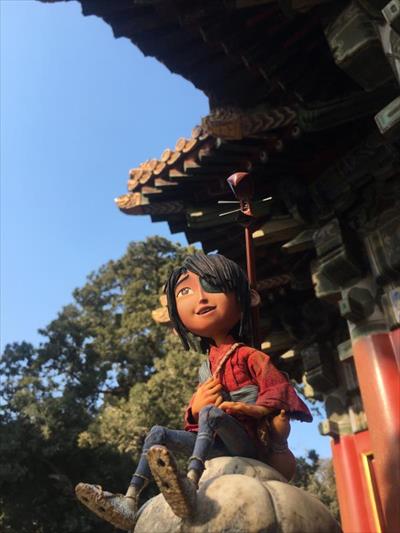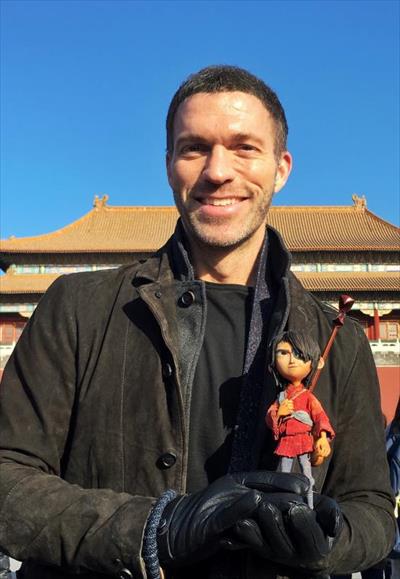| Lifestyle |
| Telling Stories that Matter | |
| East and West meet in animation film | |
|
|
 The Kubo model used in the stop-motion movie Kubo and the Two Strings (COURTESY OF INFOTAINMENT CHINA MEDIA)
Kubo and the Two Strings, produced by LAIKA Entertainment, a U.S. animation studio, got off to a good start in 2017. After being nominated for the Best Animated Feature Film and Best Visual Effects prizes at the 89th Academy Awards in January, it won Best Animated Film at the 70th British Academy Film Awards in February. Director Travis Knight sits down with China Pictorial reporters Wang Lei and Zoe Zhao to share the stories behind the film. China Pictorial: What was the inspiration for Kubo and the Two Strings? Travis Knight: I had been wanting to do a big epic movie at LAIKA for some time, and this just really contained all those elements. My mother had instilled in me a love of big fantasy stories, things like The Lord of the Rings and other fantasy works. And then, when I was about 8 years old, my father let me tag along on one of his business trips, and we traveled throughout Asia, including Beijing and Shanghai, igniting a lifelong admiration for Eastern culture. So you might say that my inspiration came from family, and we made a movie that at its core is about family. And then our character designer brought us an original idea that became the basis for Kubo and the Two Strings. I had been looking for something big, expansive and epic in nature. To make a small-scale movie, shot on a gussied-up slab of wood in a warehouse, look and feel like a large-scale epic lensed on an endless majestic vista is nigh-on impossible. It's ridiculous. Nobody would do that, which is exactly why I was excited to do it with Kubo and the Two Strings. Fundamentally, it's the same process that Willis O'Brien used in King Kong in 1933, but we've created technology and techniques that have completely transformed the medium. In terms of the plot, Kubo and the Two Strings is quite a typical American story, although the movie has incorporated plenty of elements from the East. What made you want to give an American story an "Eastern outfit?" We have found that the more intimate you make a story, the more universal it becomes. The idea of a young boy trying to reconnect with his family is a universal theme, so that makes for a story that can cast a wide emotional net. Our crew spent much time researching Eastern culture. As I said, I took my first trip to Asia when I was around 8. As I grew up in the United States' Pacific Northwest, Asia felt like home in many ways. But it was unlike anything I had ever experienced in other, very striking, ways. It was beautiful and breathtaking. My childhood introduction was the beginning of a lifelong love affair with Eastern culture. It's no coincidence that my first film as a director combines all the things I've loved deeply since I was a child: epic fantasy, animation, heroic stories on a grand scale and the beautiful, transcendent art and philosophy of Asia.  Travis Knight (COURTESY OF INFOTAINMENT CHINA MEDIA)
Previously, you mainly worked as the lead animator at LAIKA. How do you feel about your directorial debut in Kubo and the Two Strings?
Directing the film has been the most creatively satisfying experience of my life. And there's more of me in Kubo and the Two Strings than in anything I've ever done. That can be a slightly terrifying prospect: revealing a part of yourself that you typically keep shrouded and protected. But it's what we need to do if we want to tell stories that have meaning, resonance and real heart. Being a director took advantage of every single one of my earlier experiences. This film was technically demanding, but emotionally more so. Life is fuel for art, and my experiences with my family combined with a life working in animation gave me confidence that I could do this story justice. When you're the director, you're the nexus of everything. Every single decision ultimately piles up on the director's shoulders. It can be exhausting, but it's also exhilarating. You're surrounded by so many brilliant and passionate artists. You try to inspire them, but ultimately, they're the ones inspiring you. It's a beautiful collaboration. Chinese millennials and kids today are familiar with international animations, such as those from DreamWorks or Disney. What distinguishes LAIKA and its works? From the beginning, our community at LAIKA has wholeheartedly pursued the simplest of goals: to make movies that matter. Of course, that unadorned statement belies the enormous, back-breaking and mind-numbing complexity of crafting an animated film from scratch and slowly and painstakingly coaxing it to life one frame at a time over the course of many years. But putting all that aside, stripping everything else away, we're just simple storytellers. We tell stories that move us and that we hope resonate in the same way with audiences of all ages, and families in particular, all over the world. Kubo and the Two Strings is a public statement of LAIKA's commitment to telling stories that matter. Long after the thing itself is gone, our story of it can endure, thrive and grow in power and meaning. The abiding power of stories reminds me that art can transcend any given time, place and culture; draw us together over shared thoughts, emotions and experiences; and speak to that which makes us who we are. My great hope is that Kubo and the Two Strings is that kind of story. LAIKA has produced only four films—Coraline, ParaNorman, The Boxtrolls, and Kubo and the Two Strings—in the past 10 years. Is there a particular reason for this? We want to make movies that matter and to do so in a way that truly pushes the medium of animation forward. That takes time. For Kubo and the Two Strings, the time from the very start of development to the time we came to theaters was about five years. Any one animator on any given week might produce three to four seconds of footage, so we've had a good week if the entire animation team has produced a minute or two of footage. It's a slow process, but we think it's worth it. We continue to take this medium of stop-motion animation to places it has never been and to expand its storytelling possibilities. For this movie, we took techniques from theater, stage, woodworkers and machinists, traditional artists and craftspeople, futurists and technophiles, and maybe even some technophobes. LAIKA re-imagined the process to revolutionize facial replacement in stop-motion animation: for decades, the puppet's entire head was swapped out to change the facial expression, but with cutting-edge, rapid prototyping 3D printers we can create upper and lower portions of faces. This innovation yields trays and trays of facial halves, allowing our puppets to have millions of potential facial expressions. Besides, people who work at LAIKA have an innate artistic restlessness, quieted only when a story challenge has been identified and met. Kubo and the Two Strings and Travis Knight Kubo and the Two Strings, a 3D, fantasy action-adventure film, revolves around a young boy named Kubo, who has magical powers and whose left eye was stolen. Accompanied by Monkey and Beetle, he must locate a magical suit of armor worn by his late father in order to defeat a vengeful spirit from the past. The film, with Infotainment China Media as its distributor in the Chinese mainland, hit the nation's big screens on January 13 and ran until March 12. The film marks the directorial debut of Travis Knight. Better known as LAIKA's lead animator, Knight has shown with this film his ability to control the overall pace of a production. Knight was born in 1973 in Oregon, the United States. While many people have suggested that he was born with a silver spoon in his mouth, as the son of Nike founder and Chairman Phil Knight, Travis wanted to take a different road. After trying his hand as a musician—releasing in 1993 a rap album entitled Get off Mine under the name Chilly Tee—Knight realized that he was more interested in stop-motion animation, an animation technique that physically manipulates objects so that they appear to move on their own. Knight went back to university before joining LAIKA in the late 1990s, learning the trade. Subsequently, he went on to serve as the company's lead animator, president, and CEO. Copyedited by Chris Surtees Comments to yanwei@bjreview.com |
|
||||||||||||||||||||||||||||||
|
